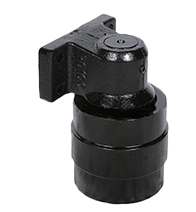ąĀąÉąŚą£ąĢąĀ
ą×čüąĮąŠą▓ąĮąŠąĄ čĆą░ąĘą╗ąĖčćąĖąĄ ą╝ąĄąČą┤čā 菹║čüą║ą░ą▓ą░č鹊čĆą░ą╝ąĖ ąĖ 菹║čüą║ą░ą▓ą░č鹊čĆą░ą╝ąĖ-菹║čüą║ą░ą▓ą░č鹊čĆą░ą╝ąĖ ąĘą░ą║ą╗čÄčćą░ąĄčéčüčÅ ą▓ ąĖčģ čĆą░ąĘą╝ąĄčĆą░čģ. ąŁą║čüą║ą░ą▓ą░č鹊čĆčŗ ą┤ąŠą▓ąŠą╗čīąĮąŠ ą▒ąŠą╗čīčłąĖąĄ ąĖ čéčÅąČąĄą╗čŗąĄ, ą▓ č鹊 ą▓čĆąĄą╝čÅ ą║ą░ą║ 菹║čüą║ą░ą▓ą░č鹊čĆčŗ-ą┐ąŠą│čĆčāąĘčćąĖą║ąĖ, ą║ą░ą║ ą┐čĆą░ą▓ąĖą╗ąŠ, ą╝ąĄąĮčīčłąĄ ąĖ ą╗ąĄą│č湥, čćč鹊 ą┤ąĄą╗ą░ąĄčé ąĖčģ ąĮąĄą╝ąĮąŠą│ąŠ ą▒ąŠą╗ąĄąĄ ą╝ą░ąĮąĄą▓čĆąĄąĮąĮčŗą╝ąĖ. ąźąŠčéčÅ čŹą║čüą║ą░ą▓ą░č鹊čĆčŗ ąĖčüą┐ąŠą╗čīąĘčāčÄčéčüčÅ ą┤ą╗čÅ ą▒ąŠą╗ąĄąĄ čéčÅąČąĄą╗čŗčģ čĆą░ą▒ąŠčé, čĆą░ąĘą╝ąĄčĆ čŹą║čüą║ą░ą▓ą░č鹊čĆąŠą▓-ą┐ąŠą│čĆčāąĘčćąĖą║ąŠą▓ ą┤ąĄą╗ą░ąĄčé ąĖčģ ąĖą┤ąĄą░ą╗čīąĮčŗą╝ąĖ ą┤ą╗čÅ čéą░ą║ąĖčģ ąĘą░ą┤ą░čć, ą║ą░ą║:
ąĪąĄą╗čīčüą║ąŠąĄ čģąŠąĘčÅą╣čüčéą▓ąŠ
ąĪčĆąĄą┤ąĮąĄąĄ čüčéčĆąŠąĖč鹥ą╗čīčüčéą▓ąŠ
ąĀą░čüą║ąŠą┐ą║ąĖ čüčĆąĄą┤ąĮąĄą│ąŠ ą╝ą░čüčłčéą░ą▒ą░
ąŚą░ą│čĆčāąĘą║ą░
ąŻą▒ąŠčĆą║ą░ čüąĮąĄą│ą░
ąöąśąÉą¤ąÉąŚą×ąØ ąÆąĀąÉą®ąĢąØąśą»
Excavators are able to rotate a full 360-degrees, while backhoes are more limited. A backhoe generally can only turn the loader arm about 200 degrees. This is a significant difference for operators. The range of rotation on an excavator saves time, as it eliminates the need to reposition equipment throughout the day,
VERSATILITY
Bot excavators and backhoes can be outfitted with numerous different kinds of attachments, making them very versatile machines. The backhoe, though, has a greater range of attachment options.
In addition, backhoes have the advantage of mobility. Since they are wheeled machines, smaller in size than the excavator, they are able to be driven up to 25 miles per hour on public roads. This is incredibly advantageous if they are needed to be moved between job sites.
PARTS OF AN EXCAVATOR
Excavators have developed immensely since the first hydraulic excavators of the late 1800s, and have continued to evolve. The basic skeleton has stayed consistent, though, with three main components: the undercarriage, the house, and the arm. These components provide supreme digging power and mobility and allow the excavator to perform its many functions.
The Undercarriage ŌĆō The undercarriage is the lowest section of the excavator. It is responsible for moving the equipment around an area. The undercarriage includes:
Tracks
Track Frames
Final Drives
Blade (on some models)
The House ŌĆō Above the undercarriage is the house, containing the power source and operator controls. The house includes:
Operator cab
Counterweight
Engine
Fuel and hydraulic fluid tanks
The Arm ŌĆō The arm is easily the most identifiable part of an excavator, extending from the body of the excavator, and responsible for the bulk of the physical work. The arm is what provides the up up-and-down and closer-and-further motions. The arm consists of:
Boom
Stick
Bucket
Attachments
ATTACHMENTS
Attachments can be utilized to suit the needs of different jobs These attachments can change the purpose of an excavator and are one of the reseasons that these machines are so versatile. The attachments can include:
Bucket ŌĆō The bucket is the most common attachment, and is ideal for digging and scooping, though they can also be used for grading stones and digging trenches.
Auger ŌĆō Fast and efficient, augers are used for drilling into the ground. They are powered by hydraulic circuits and can range anywhere between 4 to 50 inches and length, and dig all the way up to 32 feet.
Breaker ŌĆō Larger versions of a jackhammer, breakers work great for hammering through hard surfaces such as stone or concrete.
Thumb ŌĆō Thumbs are the ideal attachment for when a bucket isnŌĆÖt big enough. Easy to detach, they work well for items such as tree stumps or large slabs of concrete.
Couplers ŌĆō Couplers help to maximize the efficiency of a job site. They make it fast and easy to swap out attachments, which can save time and manpower.

ą┐ąŠą┤ą┐ąĖčłąĖč鹥čüčī ąĮą░ ąĮą░čłčā čĆą░čüčüčŗą╗ą║čā ąŠ čüčéčĆąŠąĖč鹥ą╗čīąĮąŠą╣ č鹥čģąĮąĖą║ąĄ